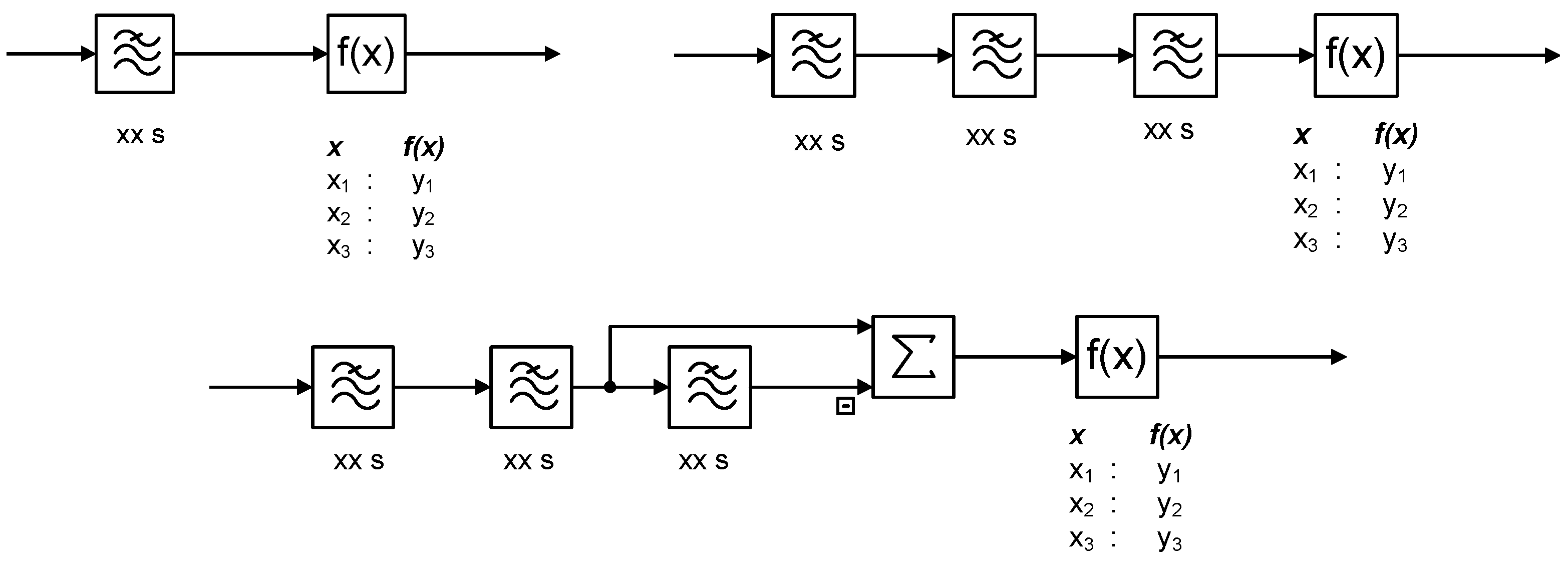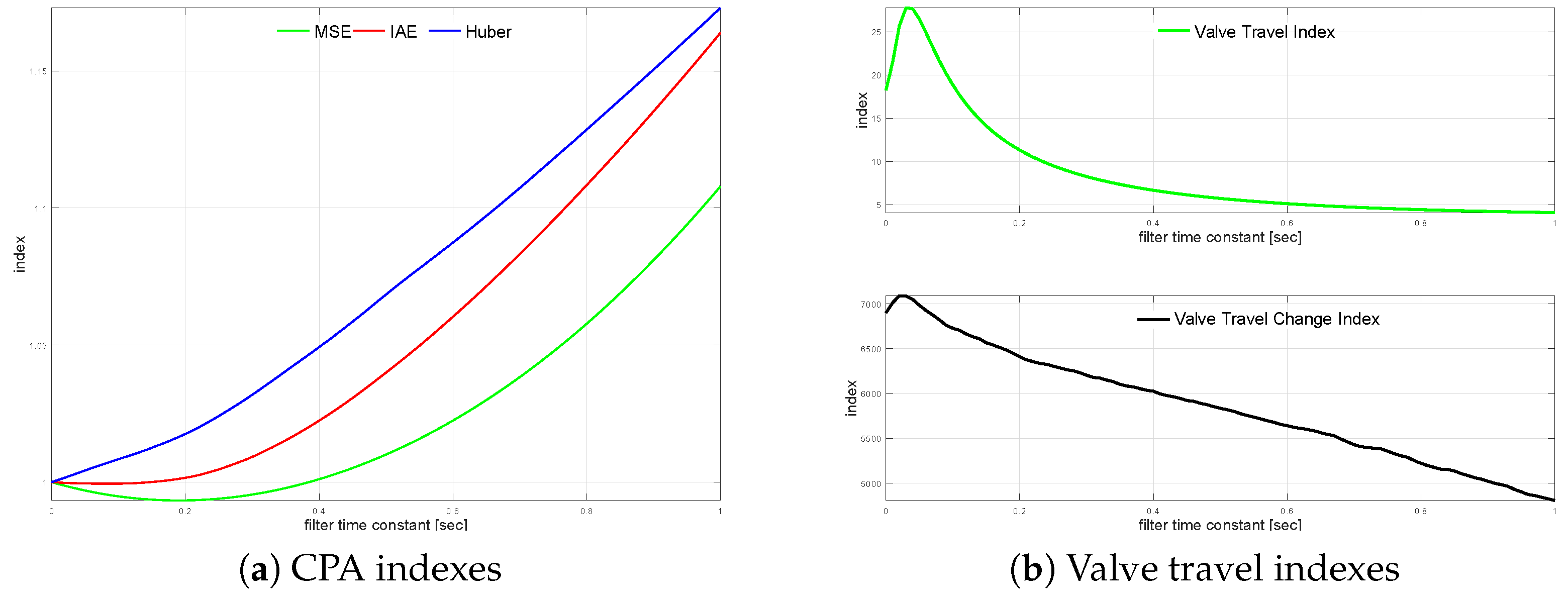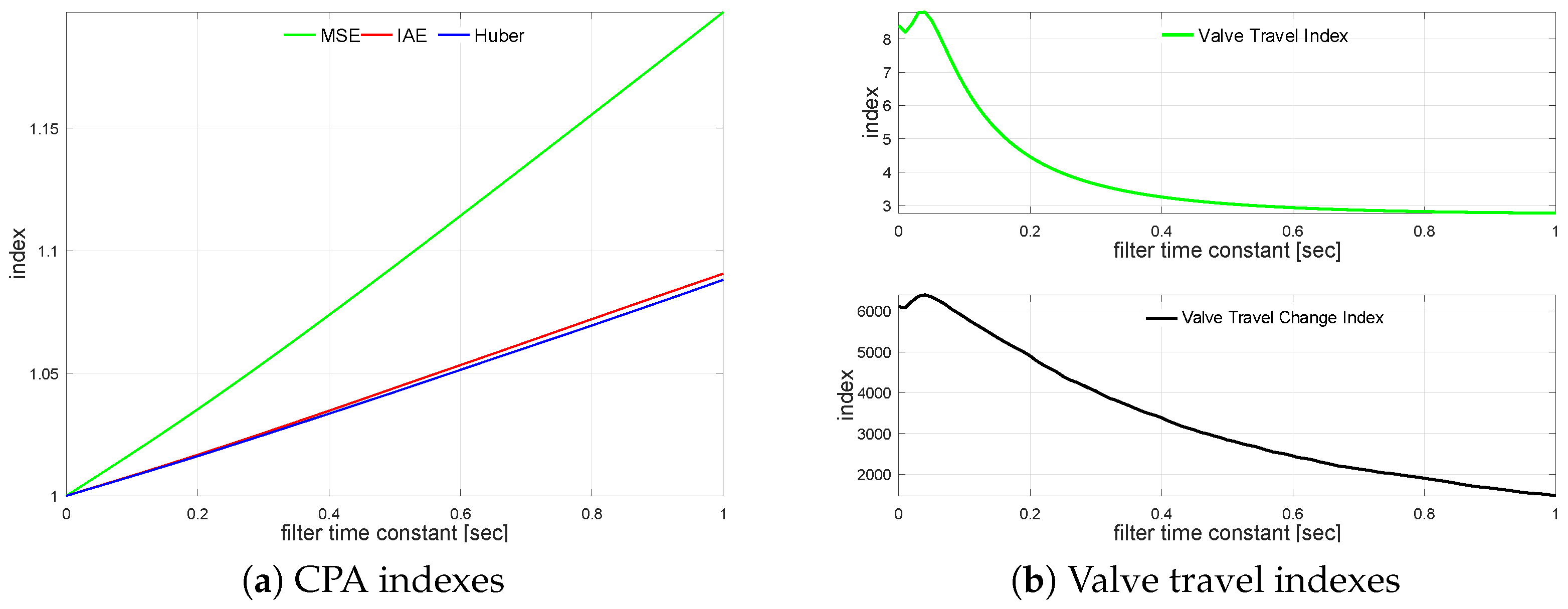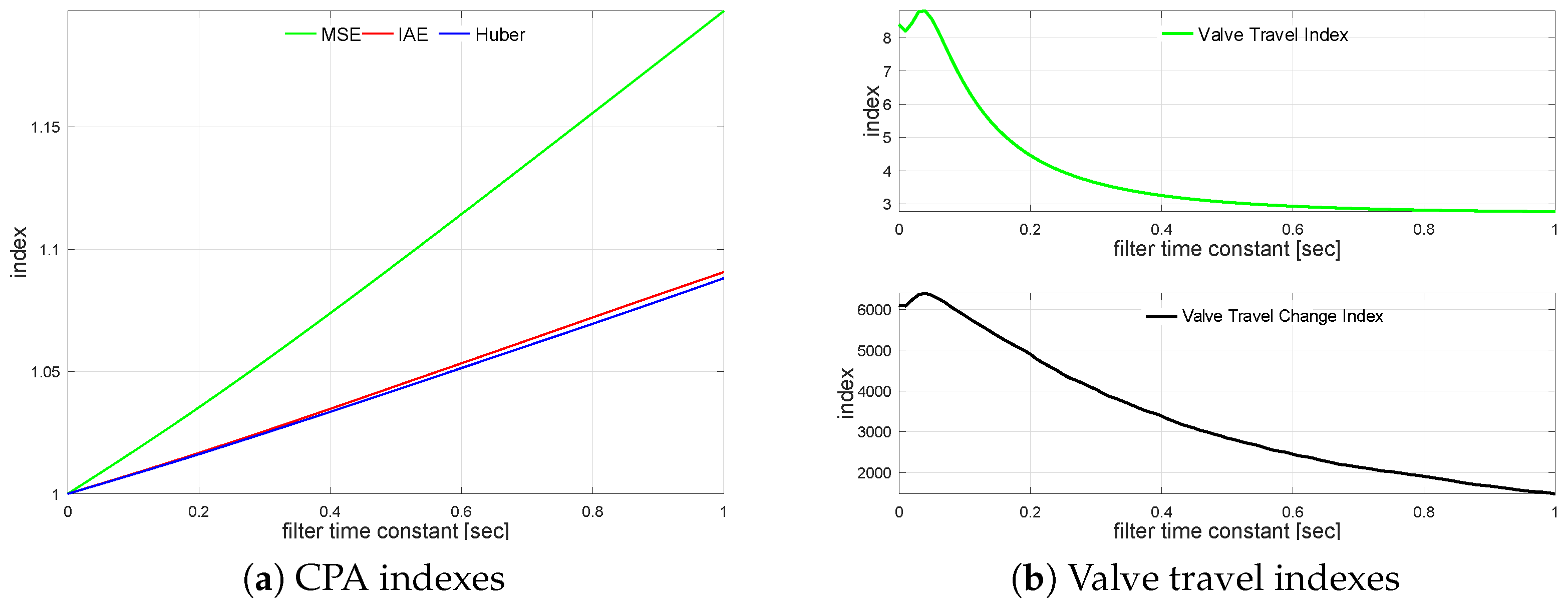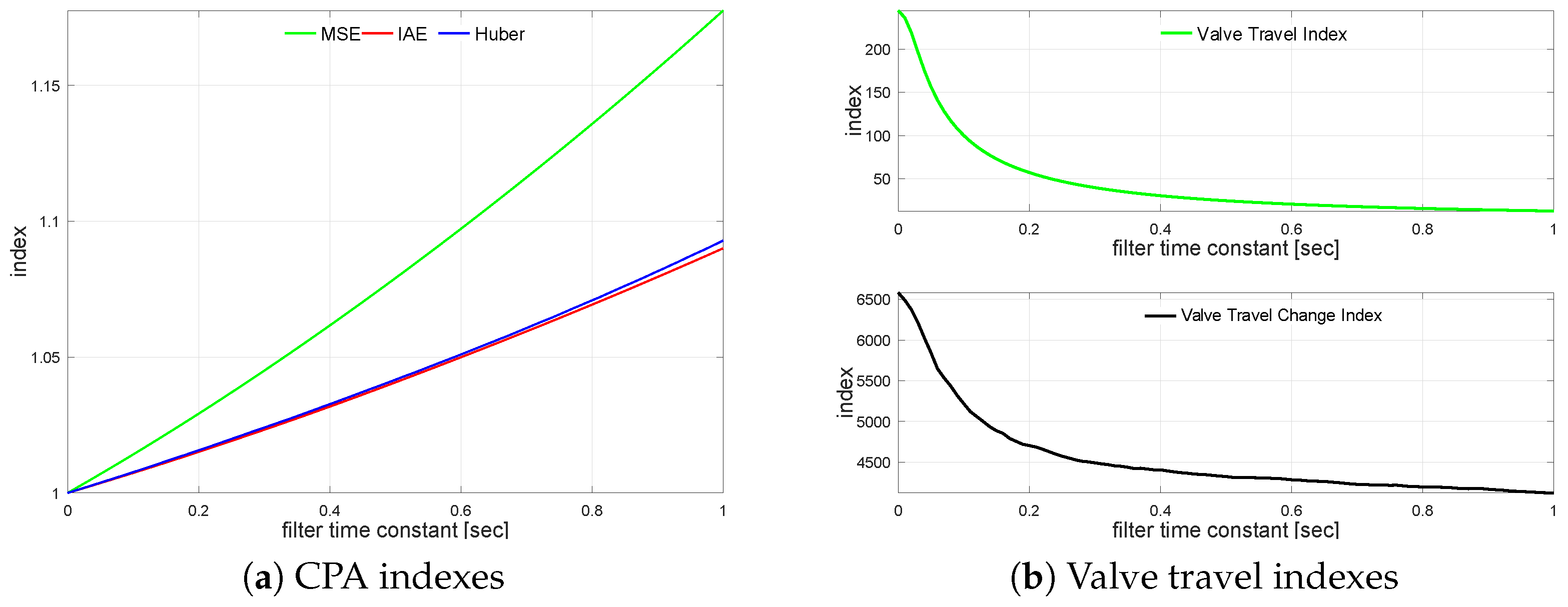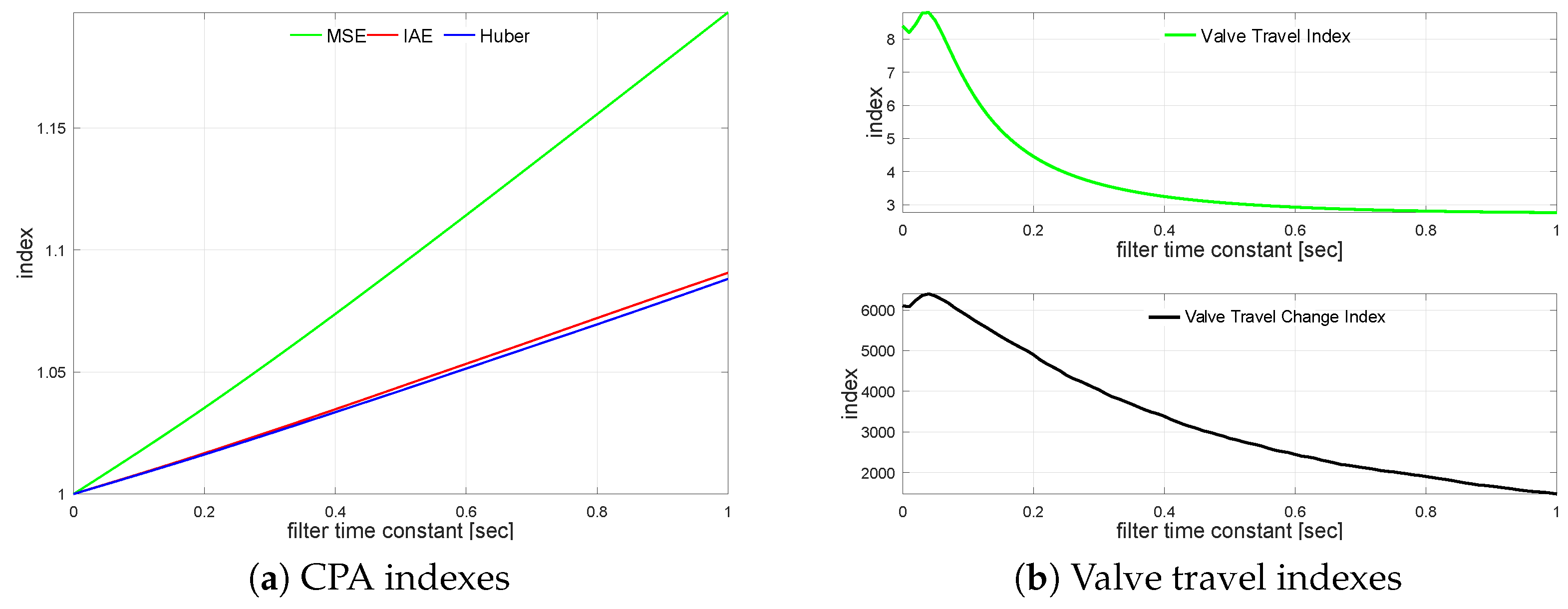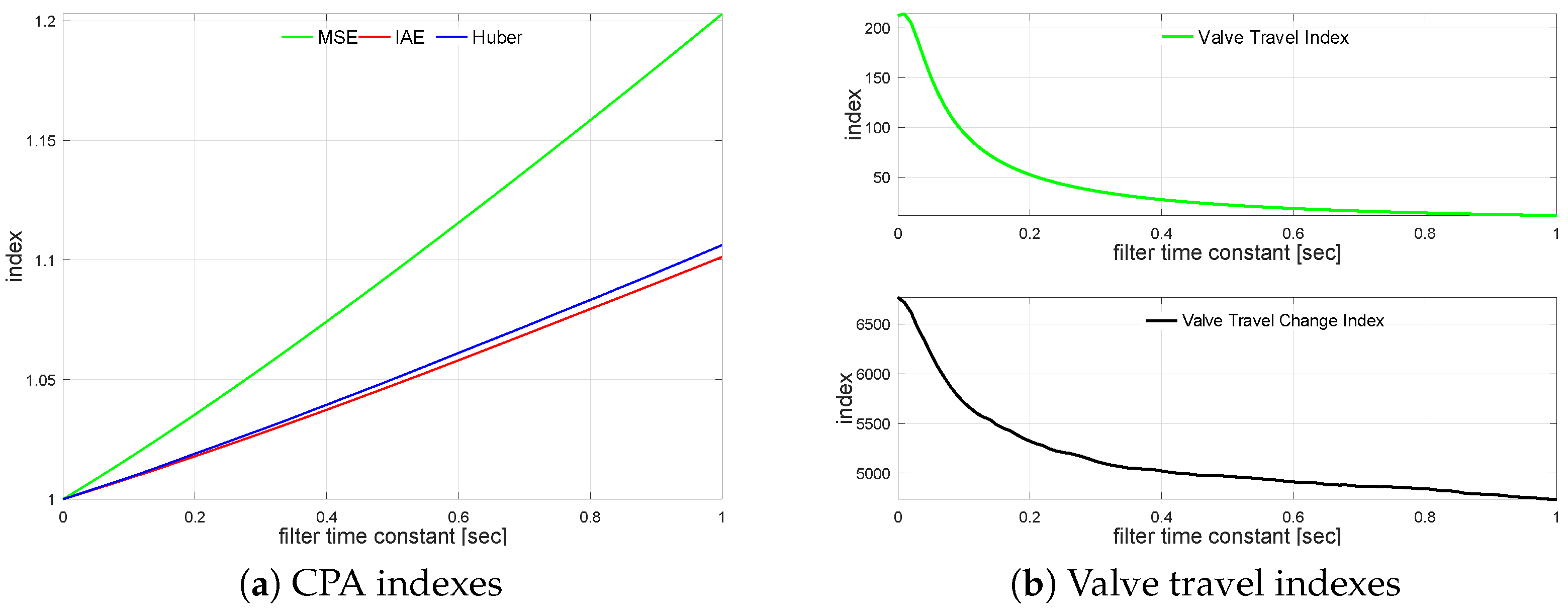The analysis uses simulations carried out with a template shown in
Figure 2. The PID control algorithm in the standard parallel form is applied as a benchmark algorithm. The standard octave function (
optiPID.m) is used to find their optimal tuning. It uses an optimization routine that minimizes the weighted performance index, which incorporates three elements: the ITAE (integral time absolute error) criterion (weighting factor
), maximum overshoot (
) and sensitivity (
) [
12]. The prepared template allows to investigate the effect of PV filtering in the univariate PID loop (CASE 1) and control error tuning in a downstream cascaded loop configuration. Each simulation consists of 1000 s sampled at
s.
3.1. Process Variable Filtering—Case 1
Process variable filtering analysis starts with multiple equal poles transfer function
. Undisturbed and noisy scenarios are compared. Selected CPA measures are calculated and shown in
Table 2 that compares ideal undisturbed loop with a noisy unfiltered one.
MSE does not aim at the noises; the impact of measurement noise is small. It is due to the squared higher incidents, such as setpoint changes, which are much more important than the noise variations. Absolute error reflects the steady-state operation (and noises) more, while robust standard deviation represents noises at most. It is also visible that the noise has a tremendous effect on the actuator performance measured by indexes
and
. Further, the controlled variable (CV) measurement filter is introduced. The loop is simulated using filter time constant values from
s up to
s incremented every 0.01 s. The filter impact on the loop is shown in
Figure 3a with a relative index change versus unfiltered one. A similar relation for travel indexes is shown in
Figure 3b. Even small values of the filter time constant improve the actuator performance, once, for larger values, the effect flattens.
MSE shows that the small time constant of the filter improves the loop performance, while slower ones (
) start to degrade the loop control quality. A similar effect is visible with IAE, but the range of loop improvement is more narrow and degradation starts sooner (
). Robust standard deviation starts to degrade just with the implementation of the filter. The effect of measurement filter on actuator performance is evaluated.
Table 3 shows a comparison of the
values: no filter, values when MSE and IAE start to degrade, and the value when
is degraded by
for
.
Undisturbed and noisy scenarios for a process with a time delay and double lag
are compared. Time trends are qualitatively similar for all plants and they are not further shown. CPA measures are evaluated and presented in
Table 4. Similar to the previous
case, MSE does not aim at the noises, while IAE focuses on the steady-state noisy operation. As in previous case, the noise has a serious impact on actuator travel indexes
and
.
The transfer function
loop is simulated using varying noise filter time constant values starting from
s up to
s incremented every 0.01 s. The measurement noise filter relative CPA index changes versus the unfiltered case on loop performance are shown in
Figure 4a. The relationship for valve travel indexes
and
is sketched in
Figure 4b.
In contrary to the previous case, valve travel index improvement starts for relatively high filter time constants. Valve travel indexes first increase (
) and start to diminish with higher filtering. Additionally, the effect on
saturates, while change index
decreases rather slowly and linearly. Although this effect is rather strange and differs from an engineering intuition, it might be explained by the coordination between process (
5) and filter time constants. The same effect can be seen in the next example as well (
6), confirming such an explanation. MSE index shows that filters with a small time constant may even improve loop performance, while slower ones (
) start to degrade the loop control quality. The effect is visible with IAE but the range of loop improvement is narrow, and degradation starts sooner (
). Robust standard deviation does not show that effect and starts to degrade just with the smallest time constant of the filter.
Table 5 shows four filters, i.e., no filter, the value when MSE starts to degrade, the value when IAE starts decrease and the value when
degrades by
for
.
Undisturbed and noisy scenario CPA indexes are presented in
Table 6. They behave in the same way as for
and
. The impact of the measurement noise filter on the loop performance is observed in the same way as for previous loops and is presented in
Figure 5a,b. The results exhibit properties similar to
. The explanation seems to be the same, as the process and filter are similar.
MSE starts to increase with a large value of the filter time constant
, while the same effect for IAE starts very soon with a small time constant
. The filter impact on actuator performance is shown in
Table 7. Time constant
reflects robust
degraded by
.
A non-minimum-phase plant
behaves similarly to
. The relationship between CPA measures and the measurement noise is presented in
Table 8. The observed behavior is very similar to the previously analyzed plants. The measurement noise filter impact on loop performance is presented in
Figure 6a. It shows the relative index change versus the unfiltered case. The relation for travel indexes is sketched in
Figure 6b.
All indexes exhibit a constant increase almost linearly as the filter time constant increases. The measurement filter impact on actuator performance is shown in
Table 9. Filter
reflects
degraded by
. Shapes for both indexes exhibit a similar behavior with short initial rise followed by the exponential decrease saturating for slower filters.
3.2. Control Error Filtering
Control error filtering analysis starts with multiple equal poles transfer function
. At first, scenarios of undisturbed and noisy environment are compared. CPA measures are calculated and presented in
Table 10 that compare ideal undisturbed loop with the noisy unfiltered one.
Indexes show that MSE is not aiming at noises, as the impact of measurement noise is relatively small. It is due to the fact that because of the squared values higher incidents, such as setpoint, changes are much more important. Absolute error reflects the steady-state operation (and noises) more, while robust standard deviation reflects mostly noises. It is shown that the noise has a tremendous effect on the actuator performance measured by valve travel indexes and .
Next, the controlled variable measurement, i.e., the process output filter, is turned on. The loop is simulated with different filter time constants varying from
s up to
s incremented every 0.01 s. The impact of the control error filter on the loop performance is presented in
Figure 7a. It shows relative index change versus the unfiltered case. A similar relationship for valve travel indexes is sketched in
Figure 7b.
MSE features much faster degradation, compared to the other two indexes. Respective curves are close to the linear. In contrast, even filtering with a small time constant significantly improves the actuator performance, once, for larger time constants, the effect starts to flatten. The curve character is exponential. Thus adding of a small time constant should give much larger improvements in the valve operational wear, without serious loop performance degradation. This observation confirms the common practice that the filtering with a small time constant is always good for a loop. Finally, the effect of the measurement filter on the actuator performance is evaluated.
Table 11 shows a comparison of the four filter
values, i.e., no filter and values of MSE, IAE and
when they degrade by
. We see that robust estimator allows the largest time constants, as it does not focus on squared errors (similar to IAE). Slight
degradation in the loop performance gives tremendous improvement in valve travel (70∼
) and a significant one in valve strokes (25∼
).
Undisturbed and noisy CPA indicators are calculated and sketched in
Table 12. Time trends are qualitatively similar for all plants, and they are not further shown. Similar to the previous
case, MSE is not aiming at the noises, while IAE focuses at the steady-state noisy operation. As in the previous case, the noise has a significant impact on both actuator valve travel indexes
and
.
The transfer function
loop is simulated using varying control error filter time constant values from
s up to
s incremented every 0.01 s. The filter relative CPA index changes versus unfiltered case on loop performance are shown in
Figure 8a. The relations for
and
are shown in
Figure 8b.
In contrast to the previous case, valve travel indicator improvement starts for higher filter values. Operational wear indexes first increase (
) and start to diminish with higher filter time constants. The effect on
saturates, while change index
decreases slower. Though this effect is rather strange and differs from an engineering intuition, it might be explained by the dynamic coordination between process (
5) and filter time constants. A similar effect is seen in the next example.
All CPA indexes increase almost linearly. MSE has the highest increase gain, while the Huber robust index has the slowest one. It is due to the outliers and squared errors that are cut off by the robust M-estimator. The effect of the measurement filter on actuator performance is evaluated.
Table 13 shows a comparison of four filter
values, i.e., no filter, and the value when MSE, IAE and
degrade by
. We see that the previous effect is observed to a smaller extent; however, still, filtering improves the valve operational wear indicators. One has to be cautious with MSE, as it is misleading—higher filtering is required as indicated by MSE.
Undisturbed and noisy indexes in
Table 14. The indexes behave in the same way as for
plant. The impact of the control error filter on the loop performance is evaluated similarly and is presented in
Figure 9a,b. The results exhibit properties as in
plant. The explanation is the same, as the process dynamics and filter are quite close.
The filter effect on actuator performance is shown in
Table 15. Highlighted values show degradation of the respective index by
. All CPA indexes increase almost linearly, with MSE exhibiting the highest gain and
the smallest.
Selected non-minimum-phase plant
behaves similarly to
. The relation between CPA measures and the noise is shown in
Table 16. The behavior is also very similar.
The impact of the measurement noise filter on the loop performance is presented in
Figure 10a. It shows relative index change versus the unfiltered case. A similar relationship for valve travel indexes is sketched in
Figure 10b.
As previously shown, all CPA indexes increase almost linearly, with MSE exhibiting the highest gain and
the smallest. The effect of the measurement filter on the actuator performance is presented in
Table 17. Highlighted values show degradation of the respective index by
. The shapes for valve wear indexes show similar properties with exponential decrease and impact saturation for slower filters.
